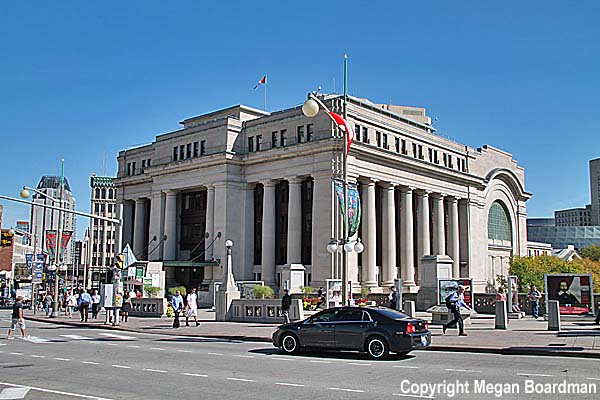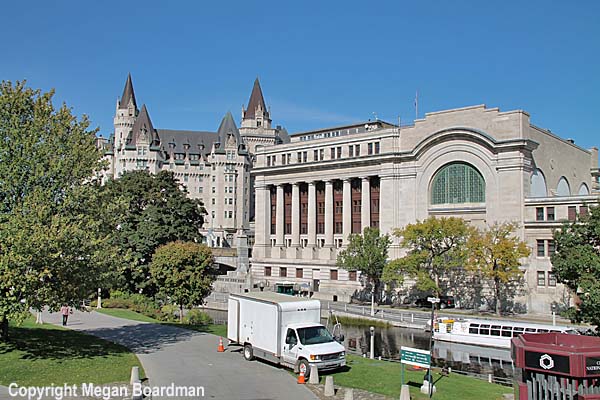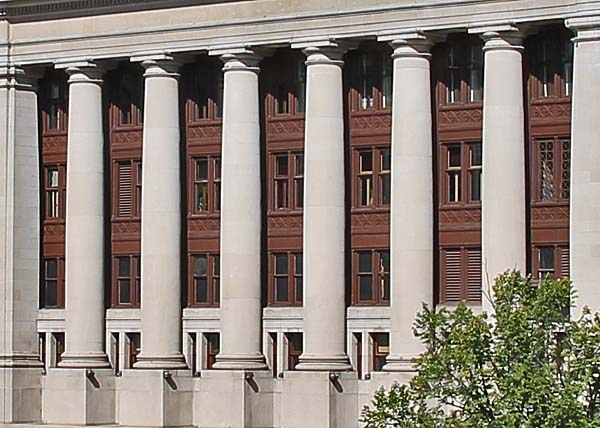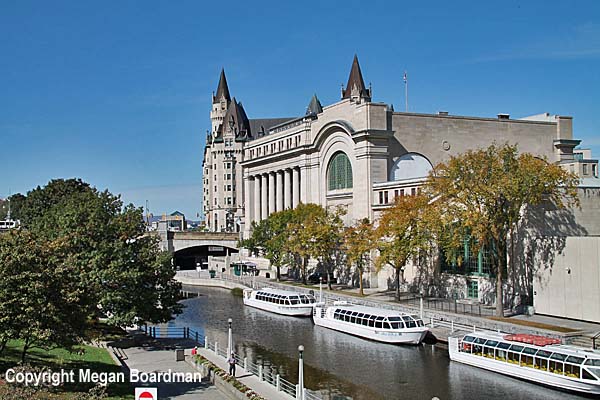Government
Conference Centre, Ottawa, Canada

Architect
|
Ross & MacFarlane
|
Date Built
|
1909 - 1912
|
Location
|
2 Rideau Street
|
Description
|
This
building on Rideau Street in Ottawa has been the
government's conference centre for 45 years and
has been the venue for many important events in
Canadian politics. However, it didn't
start out life as a conference centre. It
opened its doors in 1912 as the Grand Trunk
Railway's Union Station located across the
street from the company's hotel, the Chateau
Laurier.
The 'Heritage Ottawa' website has a detailed
history of the station building. They say
that it was described by newspapers at the time
of its opening as "strikingly beautiful"
and, I gather, a distinct improvement on the
Gothic design by Bradford Lee Gilbert that was
submitted in 1891 but rejected. In the end
the design of Ross and MacFarlane, who went on
to design Toronto's Union Station, was adopted.

An article on the Heritage Ottawa site, written
by David L. Jeanes, says that, "The
building plan and great waiting room copied
McKim, Mead & White's Pennsylvania
Station, then under construction in New
York. The barrel and groin vaulted ceiling,
arched "thermal" windows, hollow Corinthian
columns, and Roman travertine walls formed a
half-scale replica of the New York waiting
room. It was an enlarged re-creation of the
"frigidarium" of the Roman baths of
Diocletian, preserved as Michelangelo's
church of Santa Maria degli Angeli.
Around the waiting room were separate rooms
for men and women, restaurant, ticket
office, and a finely appointed Government
room with marble fireplace and mantelpiece.
They were entered though the spacious foyer
and grand staircase, a tunnel from the
Chateau Laurier, and the platform concourse
from Besserer Street. A 580 foot train shed,
the latest design of American railroad
engineer Lincoln Bush, sheltered platforms
and tracks along the Canal."
Originally the building had a shallow
dome but that was removed in 1956.

It has been designated a Federal Heritage
Building in part for its arcitectural
value. The citation describes it as, "...
an excellent example of the Beaux-Arts
tradition, a design favoured for this
building type. The ordering of both the
exterior and the interior are related
expressions of Beaux-Arts design principles.
Exhibiting the full vocabulary of classical
forms, the symmetrical composition, large
colonnades and arches of the building’s
formal entrance and linear facades express
the progression of spaces on the interior.
As well, the axial symmetry and the
progression of the interior spaces, of
varying heights and proportions, permit a
large, open layout in main spaces. Excellent
decorative treatments and materials
complement the overall design of the
building."

The building continued to
operate as a railway station until 1966
after which there was actually talk about
demolishing it. It became the
Government Conference Centre in 1968 - 69
which assured its future. The
Government of Canada, Public Works &
Government Services website, says, in a
piece written on November 21, 2013, that, "This
101-year-old heritage building is in
great need of rejuvenation. The
rehabilitation of the Government
Conference Centre will ensure the
preservation of this heritage building
and will provide a temporary home for
the Senate while the Centre Block
undergoes much needed renovations. Once
the rehabilitation of the Centre Block
is completed, the Government Conference
Centre will be made available for other
government business and used for
generations to come."

|
|

